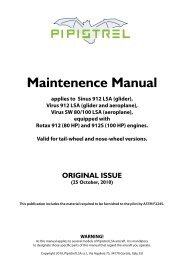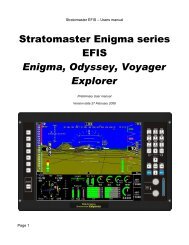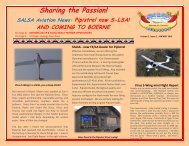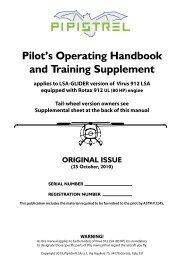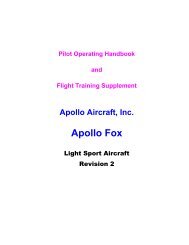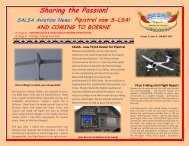Pipistrel Virus Aircraft Operating Instruction - Salsa Aviation
Pipistrel Virus Aircraft Operating Instruction - Salsa Aviation
Pipistrel Virus Aircraft Operating Instruction - Salsa Aviation
You also want an ePaper? Increase the reach of your titles
YUMPU automatically turns print PDFs into web optimized ePapers that Google loves.
Engine start-upAIRCRAFT OPERATING INSTRUCTIONS – VIRUS 912 S-LSA GLIDERMake sure both fuel valves are open and master switch in OFF position (key full left).Should theengine be cold, apply choke (lever full back). Set master switch ON (key in full right position). Setboth magneto switches ON. Avionics OFF. Engage engine starter and keep it engaged until theengine starts. Set throttle to 2500 RPM. Slide the choke lever forward gradually.CAUTION! When the engine is very cold, the engine may refuse to start. Should this occur, movethe choke handle fully backwards and hold it there for some 20 seconds to make mixture richer.Engine warm-up procedureThe engine should be warmed-up at 2500 RPM up to the point working temperature is reached.Warming-up the engine you should:1 Point aircraft’s nose into the wind.2 Verify the enginetemperature ranges within operational limits.CAUTION! Avoid engine warm-up at idle throttle as this causes the spark plugs to turn dirty andthe engine to overheat.With wheel brakes engaged and control stick in full back position, first set engine power to 4000RPM in order to perform the ignition check. Set the ignition switches OFF and back ON one byone to verify RPM drop of not more than 300 RPM. When the ignition check has been completed,add full power (throttle lever full forward) and monitor engine’s RPM. Make sure they rangebetween maximum recommended and maximum allowable RPM limits.Note that engine does not reach 5800 RPM on ground. Engines are factory set to reach maximumground RPM of 5300 - 5500 at sea level at 68° F. Maximum ground RPM may vary depending onthe season and service elevation.CAUTION! Should engine’s RPM be lower than the recommended on ground amount (min. 5100RPM) or in excess of maximum allowable RPM on ground (5800) during this maneuver, checkengine and wiring for correct installation.8.2.2 Taxiing.Release parking brake. Taxing technique does not differ from other aircraft equipped with asteerable nose wheel. Prior to taxiing it is essential to check wheel brakes for proper brakingaction. Should you expect to taxi a long way, take engine warm-up time into account and begintaxiing immediately after engine start-up. Warm-up the engine during taxiing so as not to causethe engine to overheat, as prolonged ground operation are likely to do on warm days.Holding point - Make sure the temperatures at full power range are within operational limits.Make sure the safety harnesses are fastened and doors closed and secured at all three closingpoints. Set flaps to 2nd position (flap handle full up). Power to idle.CAUTION! Should the engine start to overheat because of long taxi and holding, shut down theengine and wait for the engine temperatures drop to reasonable values. If possible, point theaircraft’s nose into the wind. This will provide radiators with airflow to cool down the enginefaster.Page 28



